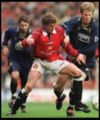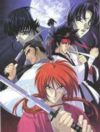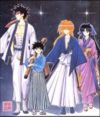|
Text © 1996, 1997, 1998, 1999, 2000, 2001, 2002, 2003, 2004, 2005 Nin
|
|||||||
|
Caravan Of Dreams |
It didn't help a bit that I was born high voltage and listened to Peter White's Caravan Of Dreams just exactly when I happened to fall in love. I said 'fall'; it wasn't like anything before and the chance to get it again tomorrow is as as fat as anorexics. So City of Lights sounded exactly like my object of affection, and it still does, today, so it isn't time-bound. This is my best-loved among Peter White's works. It flows, it's an atmosphere, no song is out of the frame and becomes an alien within its own disk. It's also so light and emits light at the same time, like fireflies.... Of course this is all very personal. You got to trust your own ears, though I surely trust mine -- but this isn't an unpaid ad and I lied when I said I liked White only because he loves cats.
|
|||||||||||||||
|
|
Ole Gunnar Solskjaer is one of my favorite footballers in the Manchester United club. But he, among the fiery Roy Keane, the glittering David Beckham, the speedy Ryan Giggs and the resilient Paul Scholes -- all are the best Man. Utd. players in my eyes, and all have been staying there through good and bad times -- Solskjaer is catching the mind's eye. The best players in my personal list are those who have been consistent and more or less staying put. That's why I almost never wrote anything about strikers -- United's included -- their glory days are usually short and thin, measured by season in and season out -- so even if they score as ridiculously as in basketball they aren't truly the thing that keeps a club aground. Except Solskjaer. All season through, 1999-2000, he walked into the stadium wrapped in a jacket and straight to the bench; Sir Alex Ferguson, the United manager, rarely put him in the starting eleven. Those were the days Andy Cole and Dwight Yorke shone brighter than the sun which by the way so thrifty when it comes to England. The Norwegian was almost always the manager's second choice; his job was only to wait just in case either Yorke or Cole caught a flu or something. His own days were, at the time, over. He used to be United's frontman. But he stayed there, looking, as always, innocent; he didn't even succeed in looking angry when talking to a reporter about his dislike of the nickname the fans worldwide had given him, 'The Babyfaced Assassin'. But he gave United the Champions League trophy despite all that. And if you count how many times he, as a backup striker who never stepped on the grass from the first minute of the game, saved United that way, you'd know how great Solskjaer is -- as a professional player who never whined out loud, as a person, as a man. In 2002-2003 Solskjaer is on the starting lineup again. And it makes no difference to him, judged from how he plays, whether he is told to sit down for 80 minutes or to run miles since the referee blows the whistle; he just gives his best shot -- like always. |
|||||||||||||||
|
Leading characters (based on Watsuki Nobuhiro's manga, published by Kodansha Ltd., Tokyo, Japan, 1994): From
left to right: Rurouni Kenshin (Samurai X) anime © 1996 Studio Gallop, Studio Deen, Fuji TV. Script by Shimada Michiru & Suga Yoshiyuki, designers Hamazu Hideyoshi, Ishii Koniyuki, Muroi Fumie & Tsuji Hatsuki, animation by Suda Masami, music by Asakura Noriyuki, directors Furuhashi Kazuhiro & Tsuji Hatsuki.
CLICK
HERE FOR
|
Nobuhiro Watsuki created the manga around the second half of the nineties. Rurouni Kenshin tells of the retirement of a professional assasin during the transition from the feudal Japanese under the Tokugawa shogunate to the Meiji era, the Japanese Enlightenment age. After centuries of feudalism where might made right in the most naked way, and 250+ years under the isolationism practiced by the Tokugawa shogunate, in late 1860's a great revolution happened in Japan, overthrowing the shogunate and restoring the actual power of governing the country into the Emperor's hands -- this was the young Emperor that in time would be known as Meiji. For time immemorial, as everyone who knew a little about Japan must have known, the country was always ruled by the strongest clan under the name of whoever Emperor of the time -- whose real power was nominal and limited to ceremonies, being designed as the 'son of Heaven' (like, now). Nobody ever tried to become Emperor, though; this has been Japan's unique collective personality that didn't even desert the most unscrupulous warlord on earth. The successive generals ('Shogun' means nothing else but 'the Imperial General', i.e. the Emperor's subordinate) from the Minamoto in early historical periods to the last of the Tokugawas only tried to grab Emperors into their sides, because otherwise the people would never dub their reign valid and justified. That's where Emperor Meiji -- or more pecisely his advisors -- differed; he wanted the real power back, like in ancient times when Emperors and occasionally Empresses really were sovereign, without any bureaucratic barrier.(Click here if you think you need 'Shoguns for Dummies' real history and pictures.) Earlier when they really didn't know better, foreign chronicles about the Meiji Restoration usually gave undue credits to Admiral Perry of the U.S. of A -- whose 'black ship' anchored at the Edo (today's Tokyo) Bay despite the Shogun's edict that said no foreigners were to be that near to the center of his realm. 250 years of never even permitted to leave the country, never allowed to build ships larger than a few feet, never to learn English (penalties for each of these crimes was death), the arrival of Perry of course created a collective mental disorder there among the people of Japan (or at least Edo). But no way a revolution came out of this sort of thing. Perry, as history later showed, only happened to be there at the time the seeds ripened to oust the shogunate. All sorts of people with every thinkable motive then joined in a temporary league to expel the 'hairy barbarians' and to get rid of the apparently useless, un-manly shogunate that had no nerve to face the Americans as it should have; the Restoration movement, like all other revolutionary bands, like, for instance, the French Revolution, was then consisted of various elements and some of them were actually just bloodthirsty murderers and other such bad seeds. Rurouni Kenshin's flocks of semi- and professional assassins that roamed freely are based on actual existence of such people of the time. Both the groups that defended the Tokugawa shogunate and the feudalism and those which upheld the Emperor's sovereignty and the new, sort of 'westernized' government were equally ruthless bloodspillers, and thus the manga and anime never got a B&W pic of people -- everything comes in gray.(Click here for the real thing of the Meiji era, with pictures). Kenshin Himura, age 28, called 'Battosai' ('The Slayer') by his enemies, was a Meiji samurai. He used to make a living by his sword since he was only 14 or 15 -- slaying Tokugawa warriors and political foes of the Meiji Restoration's upholders. Then one day he got sick of blood and decided to retire -- the usual plot, he couldn't. But Watsuki made him going through visible and drastic changes, such as using a sword that has no sharp side, by which he (of course!) still won his personal battles. The anime based on the manga is titled Samurai X here because of Kenshin's wound on his left cheek -- gotten at a winding and intricate flashback when he felt as if he killed his own wife with his own sword (he didn't). As a ronin (samurai who didn't get into any warlord's payroll), Kenshin met a hotheaded bad cook, Kaoru Kamiya, who was a kendo master. They lived together not in any sense you might wish they did. Another character that lived there at the dojo is Sanosuke Sagara, another short-tempered martial artist (kenpo, he never uses any weapon, just his fists). Sanosuke is based on another real-life person of the Meiji era, the Satsuma streetfighter Sano Takenosuke. A kid named Yahiko, 9 or 10 year-old, lived there as (a forced) Kaoru's student. A physician they rescued from a drug-dealer, Megumi Takani, is within this inner circle, too. All the adults have got disillusioned about the Meiji era. Corruption and political murders pulled them into battles, now for nobody's side but the less bad between two parties at a time; this is the red line that guides the whole series. One of the most Japanese of anime movies, Rurouni Kenshin can be said as 'patriotic'; everybody in the whole movie would really love to kick Americans out of Yokohama. Thus it freaked me out to know that this anime got sort of popular when exported to the US of A. Wow. Ignorance is wow. Usually it is taken as a fact that Watsuki constructed this tome after a historical figure known as Kawakami Gensai, a well-known 19th-century assassin who never looked a day older than his teenage years. Kawakami worked for the Restoration, but in a typical political change of climate he was sentenced to death in 1871 by the very people he killed so many for. There is a gap between the original manga and the animation in this respect -- the animators inserted side-stories never found in the manga, which in retrospect is quite mellowing (or, as some said, trivializing) the otherwise 'serious' tone of Rurouni Kenshin. Like so advertised in its official title, historical figures appear there in the manga and anime. Kenshin's first arch-enemy and also the enemy of the state, Makoto Shishio, was made to be the mastermind behind the assassination of a very important political mind of the Meiji Japan, minister Okubo; his violent death that officially brought suspicion upon the remnants of the Satsuma samurai -- those defeated in actual war against the Imperial army, who fought to restore the feudalism -- was made the reason why Kenshin changed his mind to get a permanent retirement and went to fight again. Okubo is recognised by Watsuki as the one whose idea of a nation-state originated from. In real life, a phase of the Meiji era consolidation ended with this venerable minister's death, and a fresh stock of younger ideas were to further and perfect what he championed.
CLICK THE PIX ABOVE FOR STORY & PICTURES OF REAL-LIFE ASSASSINS IN THE MEIJI ERA Rurouni Kenshin got me mostly because of the reasons I have elaborated before, the same stuff that made Ninja Resurrection appealing to me -- swordsmanship and so forth. In this case the mangaka himself got me hooked-up. Nobuhiro Watsuki, one of the best Shonen Jump Magazine's artists, is an eccentric individual to most, though there's nothing weird in him if you know writers. The artist, born on May 16, 1970, used to be described as 'shy' -- this means he stays away from publicity as far as he can, when it comes to himself (of course it doesn't apply to his works, that'd be suicidal). Not much about him is known by anybody. He still came to events like the Anime Expo in California (July 2002), but he refused getting photographed for publication, and only granted photo-ops with fans after they swore the pics wouldn't get pasted online in any way. Rurouni Kenshin's official site itself was closed down after Watsuki thought he had finished with it once and for all, in the mid-1990's. I like this sort of attitude, assuming he's been so for privacy and so on and not for dumb reasons or worse as a publicity stunt in itself. After Kenshin he wandered through the inland North America for Gun Blaze West, a shorter series of a kid growing up to bang-bang-bang. Most people considered it a failure just upon release in early 2001. But in this manga Watsuki had achieved what he longed for -- a swifter, simpler way to draw characters, and some personal triumphs, too, like, he made everybody to wear gloves -- something he always wanted to do but would have been impossible for Kenshin. That way I don't think the series that critics called 'Wild Weird West' failed. I've seen too many Japanese anime and manga. I even collect the ones I never want to see. But if I could live inside a manga I'd choose this one. I cook better than Kaoru, and my temper isn't any lamer than hers. |
|||||||||||||||
|
Footnotes: "To the bottom of every bottle": a line from the song How You Remind Me. From the album Silver Side Up, 2001. Kroeger, born in 1957, had been a worst kind of loser for so long before he got to where he's at now. Jailed for drugs possession, busy with getting senselessly drunk and committing marital abuse, and so on, the typical 20th century malady. His previous band deserted him when he was behind bars. The album Silver Side Up, my favorite, contains Kroeger's experience as the colossal jerk in the past. I'd probably have shot him in the head if I were to find him those days. Oh, well. At least now he's cured, said Santana. Freddie Krüger: Antagonist and leading character of the horror movie hit Nightmare On Elm Street. "Not bad, not late, not wrong, not long": Twisting Kroeger's lyric for the song Too Bad. The original line is "It's too bad, it's stupid, too late, so wrong, so long". Silver
Side Up
songs: Spider-Man stuff Kroeger helped to build: © 2002 Columbia Records |
I was late discovering Nickelback. It's Chad Kroeger's band since the nineties; he writes the songs, plays guitar and sings for it. Yet, Nickelback was late in discovering itself; Kroeger was too long too busy getting to the bottom of every bottle.* So I guess it's alright. Just like Peter White in jazz -- he's been there forever yet nobody I know knew him at all -- Nickelback virtually doesn't have a fan in Indonesia. The several dozens of million of rock addicts here actually love Korn and Slipknot, no matter how baseless this is; I talked about Kroeger yesterday and a friend asked me if they've released a new Friday the 13th movie this summer (he only knew Freddie Krüger!) But I'm prepared to endure such heartache for countless days to come. It's worth it. Because nothing is like Kroeger's voice. Really. He got the power, he got everything good required from a rock singer, and even if the song sucks he still saves it just by lending the voice to carry the bad, common lyric across. And this voice is, so rare these days, very sexy. You listen to him alone and let the air rocks in the middle of quietude; you'd feel like the voice is making love to you -- to some unmentionable degree of climaxes. Really. And he seems so relaxed playing the guitar, too; I love his attitude -- in music. A lot of the opposite can be said about his past -- but it ain't my business at all. About the music, Nickelback fits into my idea of rock. Not bad at all. Not bad, not stupid, not late, not wrong, not long* -- listen to them for something that's purely rocking without the need to rap and scratch innocent discs onstage like all those youngest breed in this area. Yet, the rise of Nickelback wasn't a lonely fad -- it might have been a 'movement'; simpler, 'gool ol' rock' tunes, might have made a comeback after the decade of insensible loudness in crowded sounds. It happened at the same time with the arrival of 'back to basics' bands like Staind, Coldplay and Creed. And this is a chunk of the 'why' I love Santana so much -- he collaborated with exactly the other artists I love. In Supernatural (1999) he got Rob Thomas in Smooth (really a smooth tome), Everlast in Put Your Lights On, Maña in Corazon Espinado, and Dave Matthews in Love Of My Life. Now in Shaman (2002), which actually isn't as spiffy as the predecessor, he got Seal in You Are My Kind (this sort of crappy song is written by Rob Thomas), Alejandro Lerner in Hoy Es Adios (my pick of the entire album, despite my illiteracy in Spanish -- the music is divine, though it sounds very much alike the theme song of a Hong Kong TV series about the Wu Tang swordsmen, The Silkworm Warrior), and Chad Kroeger in Why Don't You & I. The last item is like other songs he ever wrote -- only (as a matter of course) tends to sway to Latin American melodies. Kroeger doesn't sing like himself there, according to my ears. But still Kroeger's coughing is better than, say, Eminem singing -- so, no problem! The latest thing I've heard when I'm writing this is Kroeger got an award for being one of the musicians working on the soundtrack of Spiderman -- a scary epidemic craze of this blockbuster is still spreading steadily in Indonesia now. The Spiderman soundtrack CD sold here contains one song titled Dunia (The World) by an Indonesian band comprised of a few men in the middle of their twenties, that came out of the blue in the late 1990's, /rif (I'm being faithful to the way the guys write their name). Not my favorite Indonesian band, but at least /rif do dress up before going onstage. Someone, once, criticized my passion for football by saying "You MUST be ashamed of yourself. I know you love the GAME, but everybody MUST think you have a crush on David Beckham or something. Can't you ONLY be a fan of players OLDER THAN YOU ARE?" It's still safe today, football, because footballers still play when they're 10 years older than I am. If I obey the nutsy rule, I'd have to switch to other sports (like, what -- rheumatic exercise?) when there isn't anyone older than I in the stadium but the managers. But the day isn't here yet! And it's good that Chad Kroeger is a whole thirteen years OLDER than I am at any given moment, and he is, God knows, good. I don't say this just because he's a long-haired blond. I'm not that insane to revel on something inexistent at all.
|
|||||||||||||||
|
Euro 2000: regional football championship of European countries Francesco Toldo: Italian goalkeeper |
I left the chat room feeling defeated and sore. G moderated the club's discussion on the 'downs' of the Euro 2000, and Denmark is one of the worst losers there, and Peter Schmeichel was a laughing-stock, and this broke my heart for real. The team no longer played up to their own nickname, 'the Dynamites'. Oh, it did, if you imagine some explosives getting severely rained at right in the midst of a fierce world war. Even a sheer physical game wasn't theirs; Denmark was, practically speaking, knocked-out senseless since Day One by the team of Everyone. But Schmikes is still my best goalkeeper and captain in the world; until the next one comes I can't just discard the title. Francesco Toldo isn't so great while this is supposed to be the peak of his career. I still must wait for long long years to behold the young Madrid keeper Iker Casillas' best years in his career - by now I don't even know if he is going to get there. So probably Schmikes' days are over. He'd better work on his retirement plan. He's 37, anyway. Gossips say he already does, at least from the Danish national team. The net will be left to his understudy, Thomas Sorensen - who has the teacher's hothead and brawlish attitude, but never the majestic posture and not the same degree of competence yet. I'm grieving for Denmark, my second love of the European teams. But Schmikes had been a champ. This sort of thing isn't determined by winning anything later on. Once it was established, it is yours for life. Manchester United got its stairway to heaven because of, among other factors, Schmikes' contribution; Denmark won the European championship because of, in a big part, him; he helped to write the history to stay there forever. In everything, I believe it is better, much better, to be a had-been than nothing at all. It is bitter to get the headline that reads "Former Champ Badly Smashed", "The King Is Dead; Long Live The New One" - but, hey, if you were never there in the first place, what can you lose later on? To lose something is a privilege, my dear; whenever you do, just remember that so many people out there have never even gottten anything to lose to begin with. What you lose is something you have had. It cannot work in any way but that. Perhaps nobody ever hears about him today, but -- to get redundant as my mood dictates so -- Schmikes is always the goalkeeper I love most -- his golden days will stay to last among my best memories of yesteryears. Better A Had-Been © 2000 NIN |
RainForestWind/AmeMoriKaze
Personal Homepages & Other Wastelands
© 1996, 1997, 1998, 1999, 2000, 2001, 2002, 2003, 2004, 2005 NIN
|










